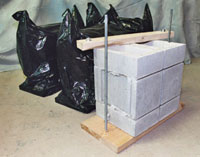For masonry under construction, we need to determine compliance with the specified compressive strength of masonry. We have two options for accomplishing this. One is the unit strength method and the other is testing masonry prisms for compressive strength.
The unit strength method verifies the compressive strength of the individual materials and then uses tables to determine compressive strength of the assembly from that information. The MSJC Specification in Section 1.4B, Compressive strength determination, is one source of tables for the unit strength method and the International Building Code (IBC) is another. They are set up similarly. They have one table for clay masonry and one for concrete masonry and each give the compressive strength of the assembly based on the strength of the unit and the type of mortar. If the wall is grouted, then the grout simply has to comply with ASTM C476, Specification for Grout for Masonry, or be the same strength as the specified strength of masonry, but not less than a minimum of 2,000 pounds per square inch (psi).
If you do not use tables, you need to know about constructing prisms to verify compliance with design compressive strength. These specimens are built at the job site. Methods for this are outlined in ASTM C1314, Standard Test Method for Compressive Strength of Masonry Prisms, which entails constructing the prisms, including grouting if applicable, and bag curing them.

Masonry prisms for compressive strength testing are constructed and then cured in plastic bags. Following initial curing, they are shipped to the lab in a rig to prevent damage during movement.(IMG15865)
The construction will be deemed acceptable or not acceptable based on the prism test results, so it’s important to do the job right. Prisms are fabricated in moisture-tight bags. Large black polyethylene bags, like heavy-duty trash bags, are common. Units are mortared together, and the resulting prisms are left to cure for 24 to 48 hours. If the construction is to be solidly grouted, the prisms are grouted at this time. Following grouting, the bags are resealed and cured for an additional 48 hours or longer. Prisms are then strapped or clamped together to prevent damage during transport to the testing laboratory. Then they are further cured, removed from the bags two days prior to compressive strength testing, and tested in compression at an age of 28 days or another designated test age. This produces values for strength of masonry to determine whether or not the as-constructed wall meets the design requirements.
Resources
Standard Test Method for Compressive Strength of Masonry Prisms, ASTM C1314-12,
International Building Code, International Code Council, Whittier, California, 2012.